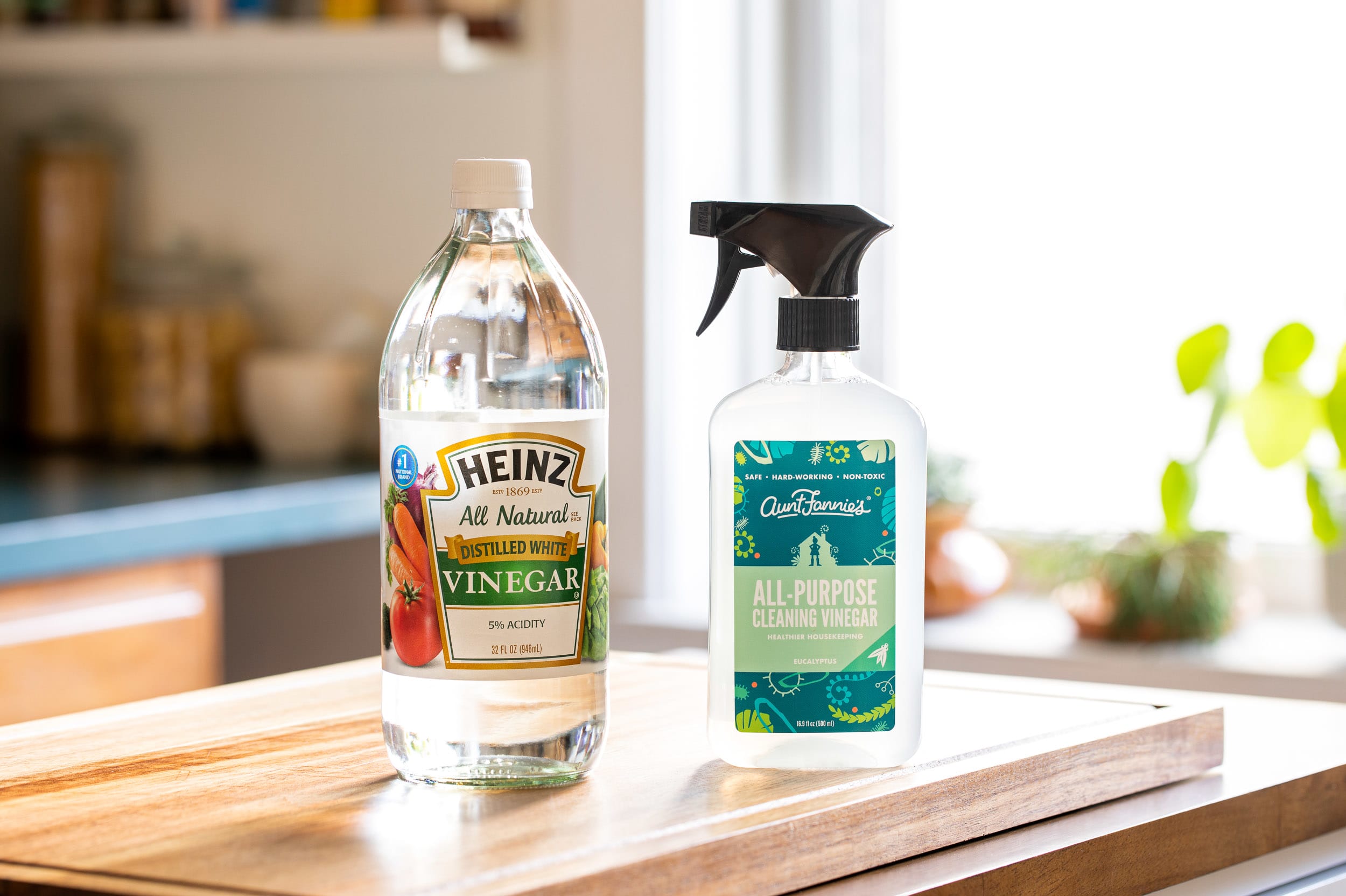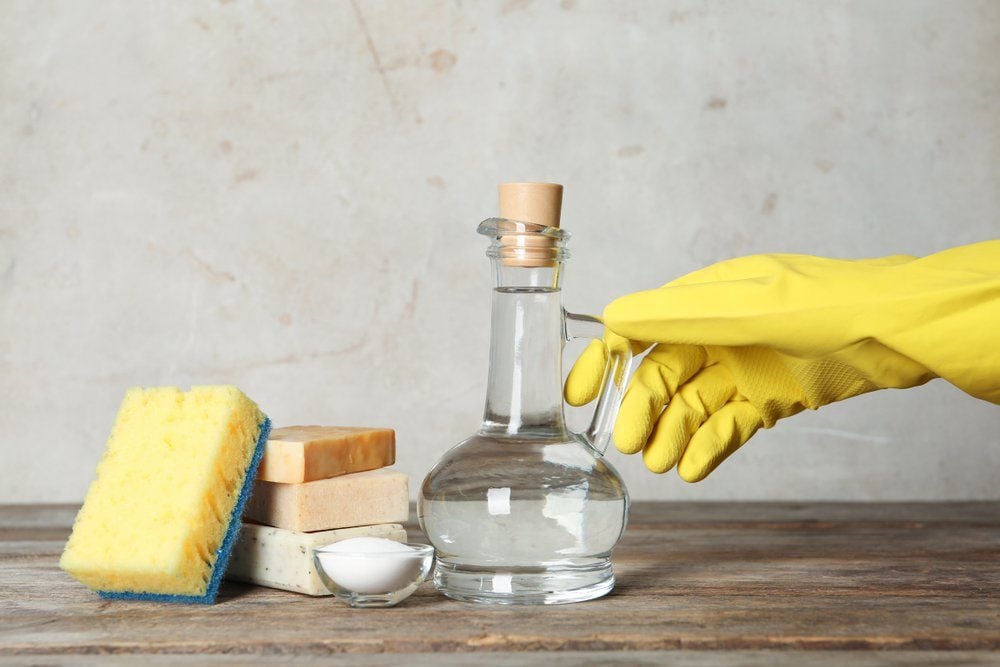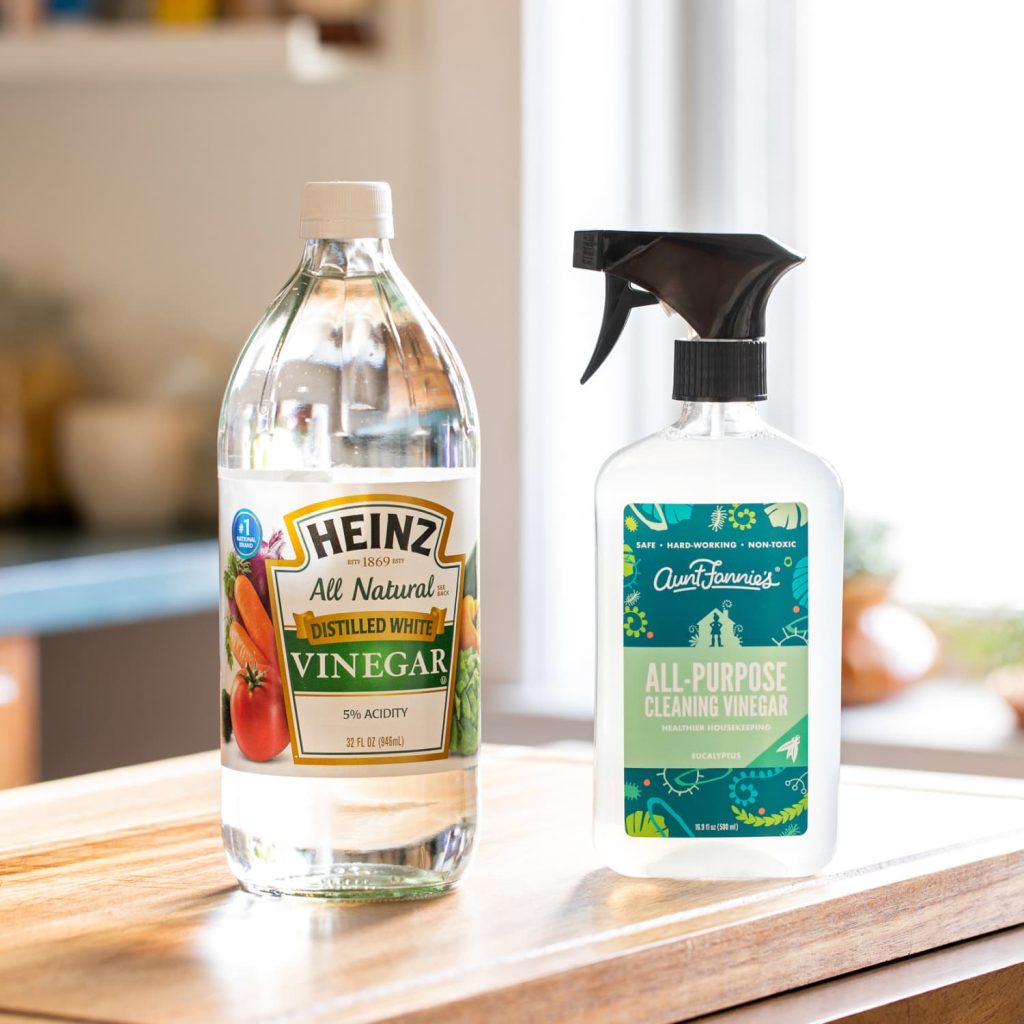Household vinegar typically contains 5% acetic acid, whereas cleaning vinegar boasts 6-8% for extra strength. The latter is not suitable for cooking, being exclusively for cleaning purposes.
Vinegar is a versatile substance known for its use in both cooking and cleaning. Among its various types, household vinegar, often distilled white vinegar, is a staple in many kitchens, used for everything from pickling to salad dressings. On the other hand, cleaning vinegar is a more potent solution that tackles dirt and grime around the home.
These two types of vinegar are formulated differently to serve distinct purposes effectively. Cleaning vinegar’s higher acetic acid content makes it unsuitable for consumption but excellent for dealing with tough household cleaning tasks. As consumers become more eco-conscious, the use of vinegar as a natural cleaning agent has surged in popularity, providing a non-toxic and environmentally friendly alternative to chemical cleaners.
Introduction To Vinegar
Vinegar touches our lives in more ways than we might expect. From tantalizing our taste buds to tweaking our cleaning routines, this versatile liquid has been a staple in households for centuries. Embark on a journey through the world of vinegar, where culinary traditions meet the practical demands of today’s homes.
Brief History Of Vinegar Use
Vinegar’s journey began over 10,000 years ago. It has been found in ancient civilizations across the world. Egyptians used it for its preservative qualities, while Romans found solace in a vinegar drink after a hard day’s work. Its medicinal properties were praised, and over the ages, it became a household staple.
Overview Of Vinegar Types And Their Base Ingredients
Vinegar comes from the French word “vin aigre”, which means sour wine. At its core, vinegar is produced through the fermentation of natural sugars to alcohol and then to acetic acid. Different vinegars emerge from varying base ingredients and fermentation processes:
- White Vinegar: Made from grain-based ethanol or laboratory-produced acetic acid, it’s clear and more acidic.
- Apple Cider Vinegar: Starts with apple cider and has a distinct apple aroma.
- Balsamic Vinegar: Crafted from grape must, it’s dark, rich, and slightly sweet.
- Rice Vinegar: Fermented from rice and popular in Asian cuisine, it’s milder and sweeter.
- Household Vinegar: A milder solution, typically at 5% aqueous acetic acid concentration.
- Cleaning Vinegar: Contains up to 6-8% acetic acid for more robust cleaning power.
Each type of vinegar fits distinct roles; while some enhance flavors, others take on the grime and grease with ease.

Credit: www.apartmenttherapy.com
Understanding Household Vinegar
Understanding Household Vinegar starts with recognizing its role in both cooking and cleaning. It’s a staple that likely holds a spot in your kitchen pantry. Let’s explore what makes household vinegar suitable for these tasks and why it differs from its cleaning counterpart.
Composition And Acidity Levels Of Household Vinegar
Household vinegar, commonly known as white vinegar, is a clear solution. It typically contains about 5% to 8% acetic acid and 92% to 95% water. The acidity level of household vinegar makes it versatile for cooking, cleaning, and even gardening. Not too strong or weak, it’s just right for everyday use.
Common Uses Of Household Vinegar In Cooking And Food Preservation
Vinegar’s unique sour taste enhances flavors in numerous recipes. Here are a few ways household vinegar is used in cooking:
- Salad dressings: Adds zest and balances sweetness.
- Marinades: Tenderizes meats and imparts flavor.
- Pickling: Preserves vegetables for long-term storage.
- Baking: Reacts with baking soda to make baked goods rise.
Vinegar also inhibits bacterial growth, making it excellent for food preservation.
Health And Safety Considerations For Cooking With Vinegar
While vinegar is safe for cooking, keep the following points in mind:
- Avoid direct contact with eyes or skin; it may irritate.
- Use in proper dilution to prevent damage to surfaces or teeth.
- Ensure adequate ventilation when using it to neutralize odors.
With these considerations, vinegar can be a safe and effective component in your cooking repertoire.
Exploring Cleaning Vinegar
Welcome to Exploring Cleaning Vinegar, a component vital in modern cleaning regimens. While commonly confused with traditional household vinegar, cleaning vinegar boasts a distinct profile. Let’s delve into this powerful cleaning agent and unravel its unique characteristics and potential within your household chores.
The Chemical Makeup Of Cleaning Vinegar
Cleaning vinegar steps up its game with a higher acetic acid concentration, usually around 6% to 8%, compared to the 5% found in household vinegar. This increased acidity means more effective cleaning power for tackling stubborn stains and build-up.
Potential Uses Of Cleaning Vinegar For Household Chores
- Disinfecting surfaces: Wipe down kitchen counters and appliances with ease.
- Descaling faucets: Banish hard water deposits for shiner fixtures.
- Cleaning windows: Streak-free shine with minimal effort.
- Refreshing laundry: Add to wash for brighter, cleaner fabrics.
- Unclogging drains: Mix with baking soda for a powerful natural solution.
Safety Measures For Using Cleaning Vinegar
| Do | Don’t |
|---|---|
| Wear gloves | Mix with bleach |
| Dilute for sensitive surfaces | Use on granite or marble |
| Ensure good ventilation | Apply to hardwood floors |
| Store safely | Ignore label instructions |

Credit: www.familyhandyman.com
Comparing Household Vinegar And Cleaning Vinegar
Welcome to our in-depth comparison of household vinegar and cleaning vinegar. These two staples have unique characteristics, and understanding those differences can empower you to use each one more effectively.
Acidity Contrast And Its Implications For Use And Effectiveness
Household vinegar typically features an acidity level of 5%. This makes it safe for cooking and flavoring dishes. Cleaning vinegar packs a punch with a higher acidity of 6% to 7%, enhancing its power to tackle tough stains and buildups.
- Removing mineral deposits requires a stronger acid, which cleaning vinegar provides.
- For food preparation, stick with the milder household vinegar.
Suitability For Different Tasks: Culinary Vs. Sanitation
| Task | Household Vinegar | Cleaning Vinegar |
|---|---|---|
| Dressing Salads | ✅ | ❌ |
| Cleaning Windows | ❌ | ✅ |
Household vinegar excels in tasty concoctions, while cleaning vinegar eradicates grime and bacteria more effectively.
Precautions And Best Practices For Using Each Type Of Vinegar
Always label vinegar bottles to avoid confusion. Here’s a quick guide:
- Food-related tasks: Use only household vinegar.
- Cleaning applications: Opt for cleaning vinegar.
- Protect surfaces: Test cleaning vinegar on a small area first.
Keep both vinegars away from children and pets to prevent any risk of ingestion or irritation.
Environmental And Economic Considerations
Environmental and Economic Considerations play a crucial role when choosing between household vinegar and cleaning vinegar. Consumers today are more conscious of their carbon footprint and are looking for cost-effective, eco-friendly alternatives for their cleaning needs. Let’s dive into the factors that distinguish these vinegars, with a focus on their production impacts and costs.
Environmental Impact Of Vinegar Production And Use
The production process of vinegar can affect the environment. Here’s what to consider:
- Source Materials: Vinegars are made from different raw materials. Some sources are more sustainable than others.
- Energy Consumption: Factories producing vinegar consume energy. Cleaner energy leads to a lower carbon footprint.
- Byproducts: The process might generate waste. Efficient management of byproducts minimizes environmental harm.
Cost Analysis: Household Vinegar Vs. Cleaning Vinegar
Here’s a comparison of costs:
| Product Type | Average Cost | Usage | Value for Money |
|---|---|---|---|
| Household Vinegar (~5% acidity) | Lower | Good for food & cleaning | High |
| Cleaning Vinegar (~6-7% acidity) | Higher | Stronger for tough stains | Depends on cleaning needs |
Household vinegar usually costs less and provides value for both cooking and cleaning. Cleaning vinegar is a bit pricier but more effective for stubborn stains.
Eco-friendly And Sustainable Vinegar Options
For the environmentally conscious, there are options:
- Organic Vinegar: Comes from non-GMO, pesticide-free ingredients.
- Locally Sourced Vinegar: Reduces transportation emissions.
- Recyclable Packaging: Less plastic waste with eco-friendly packaging.
Selecting sustainable vinegar supports the environment and reduces your carbon footprint. It often aligns with economic savings in the long term.
:max_bytes(150000):strip_icc()/SPR-what-cleaning-vinegar-is-and-how-to-use-it-5181300-hero.0366-7a5d9746a21b490ca7b08ed2bc6d6ae0.jpg)
Credit: www.thespruce.com
Conclusion And Recommendations
Now that we’ve explored the essentials, let’s wrap up our journey into the world of vinegar.
Summary Of Distinctions Between Household And Cleaning Vinegar
Household vinegar, often used in cooking, typically has a 5% acidity. Cleaning vinegar, stronger, boasts a 6-8% acidity level.
- Household vinegar is for food and gentle cleaning.
- Cleaning vinegar tackles tougher stains and build-up.
Guidance For Choosing The Right Vinegar For Specific Needs
| Need | Type of Vinegar | Why |
|---|---|---|
| Cooking | Household Vinegar | Safe and tasty. |
| Light Cleaning | Household or Diluted Cleaning Vinegar | Effective and gentle. |
| Heavy-Duty Cleaning | Cleaning Vinegar | Strong and efficient. |
Select accordingly to match your specific requirements.
Final Thoughts On The Responsible Use Of Vinegar
Always remember: with both house and cleaning vinegar, proper use is key. Wear gloves and ventilate your space when cleaning.
- Keep cleaning vinegar away from children.
- Do not mix vinegar with bleach.
- Test on small areas first.
Frequently Asked Questions For What Is The Difference Between Household Vinegar And Cleaning Vinegar
Can You Use Cleaning Vinegar Instead Of Regular Vinegar?
Yes, you can use cleaning vinegar instead of regular vinegar. Cleaning vinegar is stronger, so use it with caution.
Is Cleaning Vinegar The Same As Household Vinegar?
Cleaning vinegar and household vinegar are not the same. Cleaning vinegar has a higher acidity level, typically around 6%, while household vinegar has about 5% acidity, making it less potent for heavy-duty cleaning.
Does It Matter What Kind Of Vinegar You Use For Cleaning?
Yes, the type of vinegar does matter for cleaning. White vinegar is best due to its acidity and lack of coloring, which ensures it won’t stain surfaces.
Is Distilled Vinegar The Same As White Vinegar For Cleaning?
Distilled vinegar and white vinegar are similar and both effective for cleaning. They differ slightly in acidity levels, but either can serve for household cleaning tasks.
Conclusion
Understanding the nuances between household and cleaning vinegar can ensure you’re using the right tool for your tasks. Household vinegar is great for cooking, while cleaning vinegar’s higher acidity tackles tough stains and grime. Choose wisely for effective and safe maintenance of your home’s cleanliness.
Remember, the right vinegar can make all the difference.

